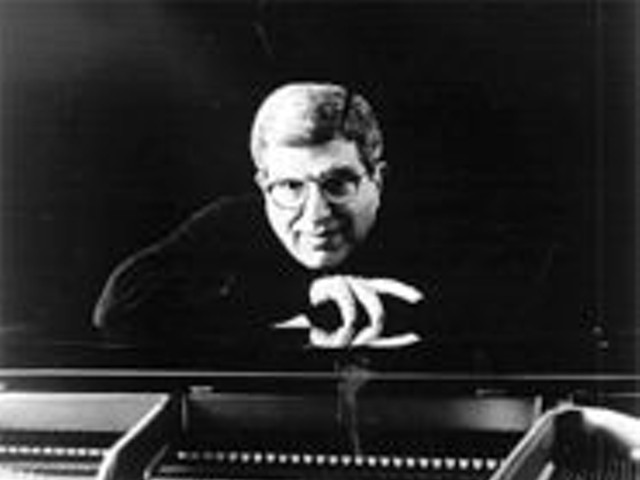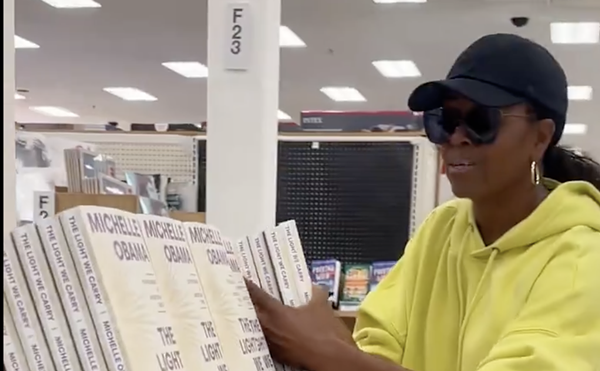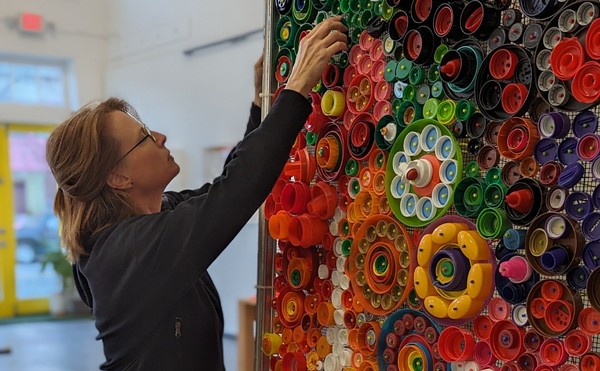Currents 96: Tim Eitel The paintings of German artist Eitel draw on historical and contemporary artworks to generate scenes of extreme enigma. The four large canvases in this show isolate figures in spare environments described only by somber gray and black fields. Helicopter (2005) has the aircraft hovering motionless just above the ground in a seemingly airless environment; Lying Figure transports Edouard Manet's Dead Toreador of 1864 to a similarly empty, vaguely interior setting. The maximum scale of the large works combines with their minimal elements to make for intriguing scenes of surreal isolation. A series of small, square oil-and-egg-tempera works on linen lines the gallery's fourth wall; these scenes are more populated but just as tight-lipped in terms of what they say to the viewer. Eitel's works are simultaneously cold and oddly irresistible. Through March 5 at the Saint Louis Art Museum, 1 Fine Arts Drive, Forest Park; 314-721-0072 (www.slam.org). Hours: 10 a.m.-5 p.m. Tue.-Sun. (10 a.m.-9 p.m. Fri.)
Great Rivers Biennial 2006 This second Biennial is exuberant, owing largely to the scale of the works. It's thrilling to see three emerging St. Louis artists let loose and work BIG. Moses has worked big for some time but rarely had the chance to show big; he's usually represented in group shows by thoughtful, smallish assemblages that yearn to grow larger. Here his walls of turntables and stereo receivers are in their proper milieu, allowing viewers to revel in their sheer size or focus in tightly on their fetishized technology — all those sleek buttons, knobs and dials, shiny like money. The Chevy Blazer outfitted with 300 speakers may be the coolest thing anyone's ever made. While Moses explores hip-hop culture, Jason Wallace Triefenbach camps out in white-trash territory with a multifaceted performance/installation whose devil is in the details: the ATM, Zebra Cakes and beer cans, the vinyl John F. Kennedy album, the framed photograph of a dog and meat. Comparisons to Cady Nolan are too facile; Triefenbach is carving out his own territory — and getting it pitch-perfect. Matthew Strauss' canvases make references to high art only to tear it apart; they're smart but wither slightly in the noisy company of his companions. Be that as it may, this is a very, very good show. Through March 26 at the Contemporary Art Museum St. Louis, 3750 Washington Boulevard; 314-535-4660 (www.contemporarystl.org). Hours: 10 a.m.-5 p.m. Tue.-Sat. (open till 8 p.m. Thu.), 11 a.m.-4 p.m. Sun.
Dan Gualdoni: Recent Paintings These 41 paintings from the artist's 2005 "aer/Eire Series" capture the crystalline light and atmosphere Gualdoni observed during a residency fellowship in Ireland. The paintings, which range in size from small to medium format (the largest is seventeen by fifteen inches), are composed of many delicately colored, translucent layers on board. Low-horizon landscapes glow through the quartz-like depths, though what the landscapes describe is difficult to determine: Here and there hills and water are clearly visible, while other works seem to depict empty, eerie landing fields or industrial parks cleared of vegetation. Some scenes feature misty skies worthy of Turner's most romantic moods; others appear completely airless. They're all beautifully strange, and Gualdoni is to be congratulated for delivering up a good measure of ambivalence that must accompany any contemporary depiction of Ireland. Through February 11 at William Shearburn Gallery, 4735 McPherson Avenue; 314-367-8020 (www.shearburngallery.com). Hours: 10 a.m.-5:30 p.m. Tue.-Sat.
Minimalism and Beyond This exhibition is perfect. The stacked and repeated boxes of Donald Judd, Dan Flavin's fluorescent lights and Richard Serra's stacked and leaning works cast new light on the minimalist idiom, which is simultaneously thematically connected to works by more recent artists like Felix Gonzales-Torres, Roni Horn, Rachel Whiteread and Robert Gober. OK, these connections have been drawn out before — but not amid Tadao Ando's minimalist architecture. Whiteread's Untitled (Gray) (1996/2003), a cast-concrete bathtub, quietly anchors the exhibition, making sensual reference to the smooth concrete of the building's walls and floor, while nearby Roni Horn's Untitled (Yes), a block of cast black optical glass, looks positively liquid in relation to the Pulitzer's water court, and Gonzales-Torres' pyramidal pile of candy in shiny silver wrappers acts as a foil to the somber character of the small Cube Gallery. The endless, subtle surprises embedded in the exhibition's layout will beckon viewers back again and again. Through April 26 at the Pulitzer Foundation for the Arts, 3716 Washington Boulevard; 314-754-1850 (www.pulitzerarts.org). Hours: noon-5 p.m. Wed., 10 a.m.-4 p.m. Sat.
New Works: Jesse Thomas and Andrea Green Snowflake's inaugural exhibit at is spare, clean and smart, like the gallery itself. Gleaming wood floors, white walls that stretch to a high, high pressed-tin ceiling — Snowflake is a perfectly lovely space and a welcome addition to the burgeoning Cherokee Street art scene. Jesse Thomas' six painted portraits owe much to the likes of Bronzino, Titian and Caravaggio, but Thomas trades in the Renaissance garb for outfits and props inspired by — no kidding — the 1980 film version of John le Carré's Tinker, Tailor, Soldier, Spy. Brilliant! Six new pieces by Andrea Green are also on view. Small in scale, they hold their own thanks to their quiet intensity: faint bite marks in paper, a bridal dress zipper cloaked in beeswax — Green handles evocative materials with a subtle surety. Through mid-February at Snowflake, 3156 Cherokee Street; 314-865-1557. Call for viewing appointments.
Philippe Parreno: The Boy from Mars The fourth installation in the Saint Louis Art Museum's "New Media" series is the most exciting to date from the standpoint of contemporary art. French artist Parreno has produced a video piece that's meditative, mysterious and somehow otherworldly. A billowing, tentlike structure, glowing gold from within, stands peacefully in a swampy, verdant setting among water buffalo. As evening descends, strange lights rise in the sky. The film reads like the documentation of an advanced culture on another planet, or Earth in an enlightened future. This is not far off the mark, for the site is an artists' community in rural Thailand, where a host of artists have come to work and contribute to the self-sustaining system that supports the place. Along with architect François Roche, Parreno designed the building, a central gathering place within the community and the mute protagonist of this film. It's strange and enigmatic, while staking a clear claim for the possibility of communities this beautiful, this harmonious, here on this planet. Through February 12 at the Saint Louis Art Museum, 1 Fine Arts Drive, Forest Park; 314-721-0072 (www.slam.org). Hours: 10 a.m.-5 p.m. Tue.-Sun. (10 a.m.-9 p.m. Fri.)
James M. Smith: Drawn Visitors to this large exhibition of Smith's drawings may at first wonder what distinguishes them from this local artist's paintings. These works, like his paintings, feature Smith's signature rough-hewn canvases, with strips of fabric sewn or safety-pinned in ragged patterns over their surfaces and raw patches of color added liberally throughout. What distinguishes these works, all produced in 2005, is not so much the medium as the foregrounding of the process of drawing — in all its various forms. Smith draws marks on his canvases, to be sure; but he also draws with the edges of his canvas strips and generates rich lines with the deep shadows and peaks of folded and draped fabric. These works are rich with lines, inscribed and described by marks and layers and applied forms. Four pieces from the "Nickel" series feature conventional drawn masses floating in open canvas fields, while works such as G-November employ and imply lines in a series of smaller canvas frames hung by wire. These works are breathtaking, somehow heartbreaking, and they will forever alter your notions of drawing in art. Through March 11 at Gallery 210, TeleCommunity Center, University of Missouri-St. Louis, 1 University Drive (at Natural Bridge Road); 314-516-5976 (www.umsl.edu/~gallery). Gallery hours 11 a.m.-5 p.m. Tue.-Sat.
Social Commentary in Black and White This modest exhibition of prints by Tom Huck, Bill Fick and Richard Mock delivers a serious punch and a chance to see works by three of the finest, sickest printmakers working today, in one place. The show also features works by University City High School students who worked with Huck during his residency at the school. Printmaking is an immediate, forceful medium of communication. Huck's works are some of the finest prints being made, and he clearly has a talent for communicating with young artists, whose efforts carry jarring imagery and heartfelt messages. Through March 26 at the Center of Creative Arts, 524 Trinity Avenue, University City; 314-725-1834 (www.cocastl.org). Hours: 10 a.m.-6 p.m. Mon.-Fri., noon-5 p.m. Sat.-Sun.
Alfred Stieglitz This small (eleven prints) stairwell exhibition is a lovely survey of photography's early high period, as well as a telling tribute to an artist who is remembered as much for his editorial and curatorial work as he is for his own photography. Ranging from his late-nineteenth-century work in Germany to his far more abstract images from the 1930s, the works on view here include some of Stieglitz's best- and least-known photographs: the nostalgic November Days (1886) and The Old Mill are soft, glowing platinum prints; The Terminal (1893) is shown in its photogravure printed form in a 1911 issue of Camera Work; the small, moody "Equivalent" cloud images from the 1920s verge on total abstraction; and From the Shelton West (1935), a gelatin silver print of New York skyscrapers, captures the dramatic urban lines and contrasts that fascinated modern artists at the time. Whether you know a little or a lot about Stieglitz, this show is well worth a long pause in the stairwell. Through March 26 at the Saint Louis Art Museum, 1 Fine Arts Drive (in Forest Park); 314-721-0072 (www.slam.org). Hours: 10 a.m.-5 p.m. Tue.-Sun. (10 a.m.-9 p.m. Fri.)





